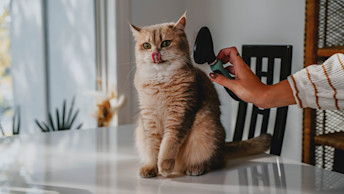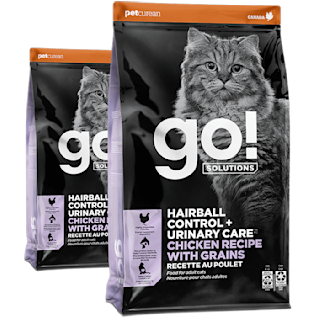February 22, 2024
How to Prevent Hairballs in Cats Naturally

Does your cat frequently cough up hairballs on your furniture and floors? The sight and sound can be unpleasant, not to mention the cleanup.
Hairballs occur when your feline friend grooms itself and ingests loose fur, which binds together inside the digestive tract. Eventually, the furball travels back up the esophagus and is expelled through the mouth. While occasional hairball ejection is normal, chronic issues point to an underlying problem.
With a healthy diet and regular grooming, you can minimize excess shedding, support your cat’s healthy digestion, and minimize those pesky hairball regurgitations. Read on to understand why hairballs happen and how to help curb them, naturally.
What Causes Hairballs in Cats?
As cats lick their coats to clean and detangle their fur, they swallow hair. Generally, this ingested fur passes naturally in the stool. However, for particularly meticulous groomers or those who groom other cats in addition to themselves, a greater amount of hair is swallowed than can be passed. The swallowed fur can bind together with mucus inside a cat's stomach and form a hairball. The fur becomes compressed into a dense mass that is too large to pass easily through the intestines.
The more hair cats ingest, the more likely a hairball will form.
Long haired cats like Persians and Maine Coons are at a higher risk of hairballs since more fur tends to get trapped in their long fur and swallowed during grooming. But it’s important to note that even short-haired cats can get hairballs.
Cat Hairball Symptoms
Hairballs can cause various symptoms in cats that pet parents should look out for. Some of the most common signs of a hairball include:
Coughing or retching noises - One of the classic signs of a hairball is when a cat starts making coughing or retching sounds. They may frequently try to hack up hairballs. The retching noises can sometimes be loud and dramatic.
Constipation - Hairballs can lead to constipation in cats3 since the mass of hair makes it difficult to pass stool. Constipation from hairballs may involve straining to use the litter box with no results.
Vomiting hairballs - Occasionally a cat will vomit up a hairball they've been trying to pass. It will look like a sausage-shaped mass of fur. Vomiting provides relief but does not mean that more hairballs won’t accumulate.
The occasional hairball regurgitation is not necessarily cause for alarm; however, it is important to do a workup with a veterinarian to ensure that there are not underlying reasons for the regurgitation. Hairballs can be dangerous if they cause a blockage in your cat's digestive tract. Make sure to take your cat to the vet immediately if you notice a change in your cat’s appetite or energy levels or if your cat has retched repeatedly and nothing has come out5.
Natural Dietary Hairball Remedies
One of the most common ways to prevent hairballs in cats is by including key ingredients in their diet to encourage passing swallowed hair in their poop. There are several key ingredients and dietary changes you can make that have been shown to reduce hairball regurgitation.
High Fibre Foods
A diet rich in fibre, especially insoluble fibre, can help your cat naturally pass swallowed hair before it forms into a hairball4,9.
There are two primary types of fibre, soluble and insoluble. Soluble fibre dissolves in water to form a gel-like substance, which can help cats feel full, and contains prebiotic fibre to support a healthy gut microbiome. Insoluble fibre helps maintain digestive health by adding bulk to the stool, promoting regular bowel movements, and can help with constipation by keeping things moving1,8.
Look for cat foods that list vegetables, fruits or pumpkin towards the top of the ingredients list to incorporate more fiber into your cat’s diet.
Check the fibre content of your cat’s food and select a diet that contains a higher amount of crude fibre. Typically, a food with more than 7% crude fibre provides an appropriate amount of insoluble fibre.
Miscanthus Grass
Ever wonder why cats routinely consume grass and other plant material? In addition to providing them enrichment, consuming grasses can support hair elimination and gut movement2,6. Miscanthus grass is fibrous in nature and features a high insoluble fibre content, making it an effective natural ingredient to help maintain healthy digestion and discourage hairball formation7.

Psyllium Husk
Psyllium husk is a valuable component of hairball diets due to its exceptional properties that aid in digestive health. It’s rich in soluble fibre, which can help support regular bowel movements and help prevent the formation of hairballs in cats. Psyllium husk can also help maintain optimal moisture levels in the digestive tract, ensuring the smooth passage of food and minimizing the risk of constipation1,7.

Recommended Solution
New Go! Solutions Hairball Control + Urinary Care Cat Food
Featuring fiber-rich miscanthus grass and psyllium husk to help cats pass swallowed hair and discourage hairballs.
View recipe
Omega Fatty Acids
Omega fatty acids support healthy and hydrated skin, and a lustrous coat, which in turn can help shedding be kept to a minimum. Look for cat food high in omega-3s and omega-6s from fish, plant oils, or flaxseed.
Increase Moisture
Keeping your cat well hydrated can help soften stool and allow the hair to pass through uneventfully. Mixing their kibble with bone broth or water can help increase moisture intake. Wet food also has high water content.
By modifying your cat's diet to include more natural fibre from ingredients like psyllium husk and miscanthus grass, omega fatty acids, and moisture you can help to minimize hairball occurrence. As with any dietary change, be sure to introduce a new food slowly and monitor your cat to ensure they are tolerating the new foods well. A high quality diet optimized for hairballs is ideal for prevention.
Grooming Tips
Regular grooming is essential for reducing hairballs in cats. Frequent brushing with a soft bristle brush will remove loose hair and prevent it from being ingested, not to mention reducing excess hair around your home! Focus on gently brushing areas where fur tends to mat or tangle, such as the belly, behind the legs, and around the tail.
Prevention is Ideal
Preventing hairballs from forming in the first place is the best way to avoid problems. By implementing some key dietary and grooming changes, you can greatly reduce the chances your cat will get a troublesome hairball.
Dietary Changes - As we've discussed, incorporating certain foods into your cat's diet can help move hair through the digestive tract. Foods containing ingredients like psyllium husk or miscanthus grass are great options.
Regular Grooming - Brushing or combing your cat's coat daily helps remove loose hair before it's ingested. Use a de-shedding tool or slicker brush and focus on areas that get matted easily.
Following these tips consistently makes it less likely your cat will end up with an obstructing hairball. However, it's still ideal to monitor for any signs of distress and consult your vet if concerned. Being proactive with diet, grooming, and environment is the key to preventing hairball problems.
Alves, J.C., Santos, A., Jorge, P., et al. 2021. "The use of soluble fibre for the management of chronic idiopathic large-bowel diarrhoea in police working dogs." BMC Veterinary Research 17, 100. https://doi.org/10.1186/s12917-021-02809-w.
Castañeda, I., Zarzoso-Lacoste, D., & Bonnaud, E. 2020. "Feeding behaviour of red fox and domestic cat populations in suburban areas in the south of Paris." Urban Ecosystems 23: 731–743. https://doi.org/10.1007/s11252-020-00948-w.
"Constipation in Cats." VCA Canada. Accessed February 12, 2024. https://vcacanada.com/know-your-pet/constipation-in-cats.
Donadelli, Renan A., Titgemeyer, Evan C., Aldrich, Charles G. 2019. "Organic matter disappearance and production of short- and branched-chain fatty acids from selected fiber sources used in pet foods by a canine in vitro fermentation model." Journal of Animal Science 97, no. 11: 4532–4539. https://doi.org/10.1093/jas/skz302.
"The Danger of Hairballs." Cornell Feline Health Center. Accessed February 12, 2024. https://www.vet.cornell.edu/departments-centers-and-institutes/cornell-feline-health-center/health-information/feline-health-topics/danger-hairballs.
Franck, AR., and Farid, A. 2020. "Many species of the carnivora consume grass and other fibrous plant tissues." Belgian journal of zoology 150.
Iqbal, M. A., Donadelli, R., & Aldrich, G. 2022. "Miscanthus Grass as a Nutritional Fiber Source for Monogastric Animals." In Grasses and grassland: New perspectives, 71–80. IntechOpen. https://books.google.ca/books?hl=en&lr=&id=PLGTEAAAQBAJ&oi=fnd&pg=PA71&dq=miscanthus+grass+hairball&ots=HwpdQavEjK&sig=NpGxFHyFs4p4LBbXjfHrKgVd8L4&redir_esc=y#v=onepage&q=miscanthus%20grass%20hairball&f=false.
Moreno, A. A., Parker, V. J., Winston, J. A., & Rudinsky, A. J. 2022. "Dietary fiber aids in the management of canine and feline gastrointestinal disease." Journal of the American Veterinary Medical Association 260, S3: S33-S45. https://doi.org/10.2460/javma.22.08.0351.
Weber, M., Sams, L., Feugier, A., Michel, S., and Biourge, V. 2015. "Influence of the dietary fibre levels on faecal hair excretion after 14 days in short and long-haired domestic cats." Veterinary Medicine and Science 1, no. 1.



